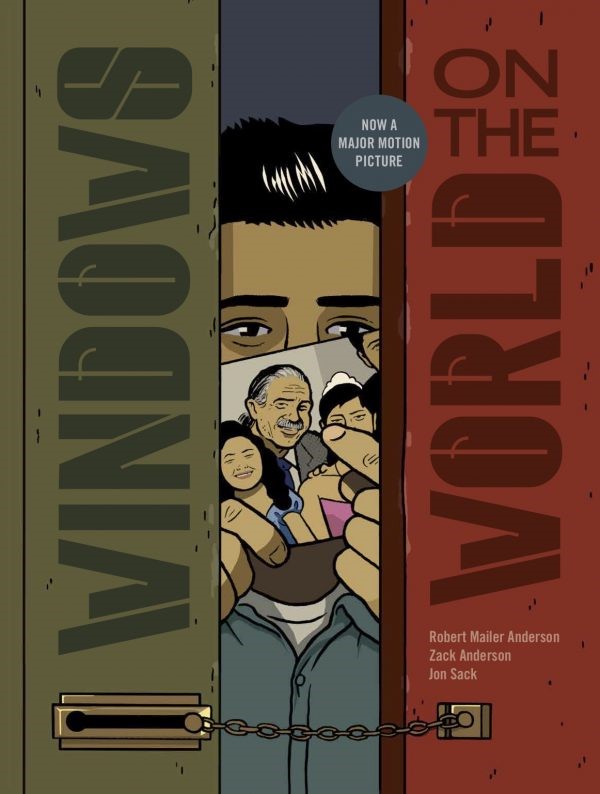
Popular mythology has it that “America was never more united” than in the immediate aftermath of the terrorist attacks of September 11th, 2001, and that we’ve somehow devolved into a divided and fractured nation in the years since. The simple fact, though, is that almost no other country sugar-coats its own past the way the United States does, and that a very direct line can be traced from the “fortress America” nationalism that took hold after 9/11 to the openly anti-immigrant sentiments that are all all too depressingly common today. It’s just that no one talks about it — or, rather, no one talked about it until now.
With a looming election that’s being portrayed as an existential choice on our country’s future (or, if you’re a cynic like me, a clash between the former status quo and a new, even uglier and more destructive one), Robert Mailer Anderson, Zack Anderson, and Jon Sack’s new Fantagraphics-published graphic novel, Windows On the World, probably couldn’t be coming at a better time — but it’s not timely despite its story taking place in the months following 9/11, it’s timely because of its historical setting. And while this may be a fictitious narrative on paper, it’s as thematically “real” as anything you’d care to mention. In some respects, in fact, it’s painfully real.

Tell me this scenario doesn’t sound about as non-fictional as it gets: Balthazar is an undocumented Meican immigrant who works a job in New York bussing tables at the iconic (and, in this case, titular) Windows On The World restaurant atop the World Trade Center. When the Towers are destroyed, the money he’d been sending back home to his family dries up, and, while his wife begins to crack under the strain of taking care of pretty much everything, his headstrong son, Fernando, takes it upon himself to journey north and attempt to learn his father’s fate. Fernando’s sense of resolve only grows stronger when TV news footage shows a guy who looks an awful lot like his father running down the street, away from the carnage. Or so his mother claims, at any rate — but is this just wishful thinking on her part? And if her eyes didn’t deceive her, then why has her husband not managed to make contact with any of them?
Yes, there are any number of intrigues at play here, but they’re not the heart and soul of the story. As Fernando makes his way toward New York and is confronted with every aspect of American life, from prejudices both covert and less so to the kindness of strangers in tightly-knit immigrant communities, he learns that it’s not so easy to find someone whose very continued presence in a country is predicated upon them remaining hidden, and that a law enforcement and immigration system that person is hiding from isn’t of much use when it comes to finding them. Granted, the chaos that followed the collapse of the Twin Towers doesn’t make Fernando’s predicament any easier, but it’s clear that systemic rot and bureaucratic unconcern were long-standing issues prior to that tragedy, and that the dysfunction has only increased since. Granted, Muslims were the primary target of authorities — and the public — at that time, but Fernando and his fellow Mexicans are also necessarily demeaned and dehumanized by a system designed to keep them in the shadows and exploited for cheap labor in equal measure, and the trajectory from this less-than-benign-neglect to “they’re sending rapists, they’re sending criminals” Trumpian rhetoric is as clear and obvious as it is tragic.

Interestingly, this book’s route to publication appears to have been nearly as circuitous and uncertain as the plight of its protagonist. Originally conceived of as a screenplay, the Andersons apparently got together with artist Sack when they had difficulty shopping around their script, only to see it optioned and, in fact, made into a film after he had begun work drawing it. And so the movie (which, full disclosure, I haven’t seen, but certainly intend to) ended up coming out before the comic, even though it was “translated” into comics format precisely because a movie was looking like an unlikely proposition at one point. Go figure.

In any case, we should be very glad indeed that this did, at the end of the day, see the light of day as a graphic novel (a term that well and truly applies in this case), not just because of the moving and immersive story, but because Sack’s humane and sensitive art, replete as it is with fairly unmistakable Adrain Tomine and Dan Clowes influences, is masterful at communicating not only expression, but scale, never letting us forget that Fernando is one small, albeit brave, person facing insurmountable odds. It may be a bit of a reach to say that there’s a bias against collaborative works done by writer/artist teams in the field of so-called “alternative” comics — I’d prefer to think that there is, rather, a bias in favor of works made by a single cartoonist (which may sound like splitting hairs to some, but I think the distinction is an important one) — but in this case, readers would do well to put that presumption aside and appreciate the near-seamless narrative fluidity that the Andersons and Sack have achieved here. A good comic is a good comic, after all, whether made by one person or by committee, and Windows On The World is one of the most topical, relevant, and necessary comics out there right now.
SOLRAD is made possible by the generous donations of readers like you. Support our Patreon campaign, or make a tax-deductible donation to our publisher, Fieldmouse Press, today.

Leave a Reply